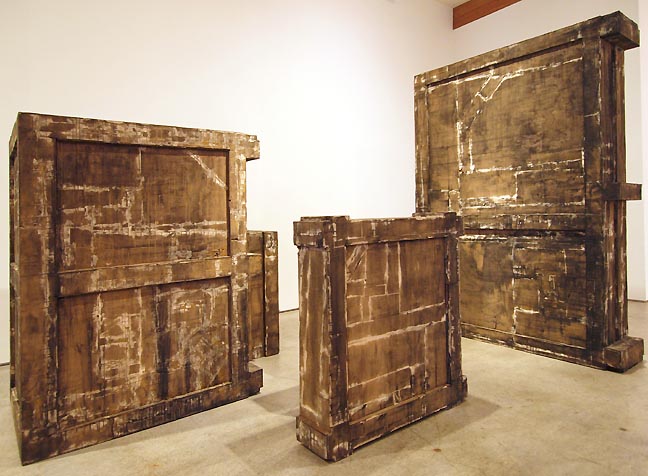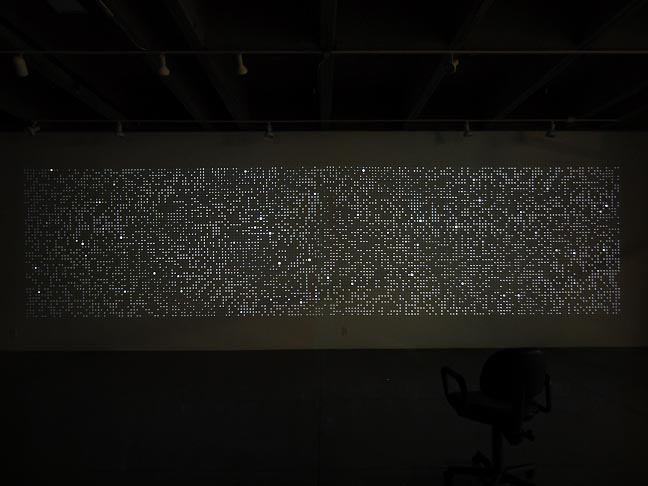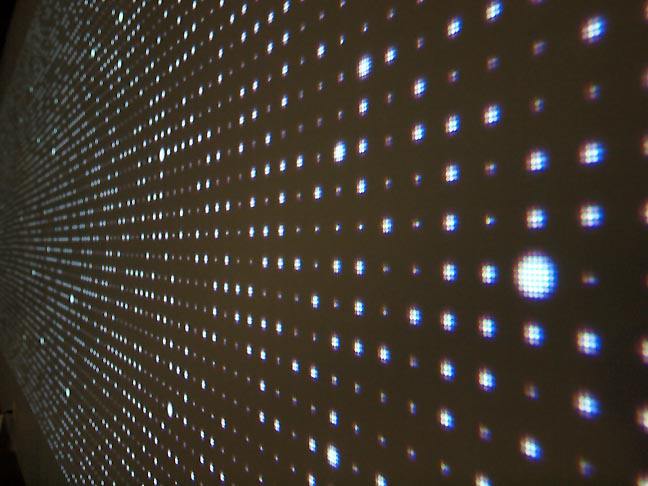
|
||
|
Portland art blog + news + exhibition reviews + galleries + contemporary northwest art
|
||
Vastness: Joe Thurston and Arcy Douglass In this month of Rothko's vast personal spaces populated by nothing but color and texture two current Portland artists, Joe Thurston and Arcy Douglass (a PORT contributor) have also found a way to tap into a related sense of the endless. In fact, they are two of the most convincing solo shows by living Portland artists in recent memory. Yes, people make a big deal of group shows, mostly as a kind of social event but it is solo shows such as these, which ultimately determine who is who. In this case both Thurston and Douglass, though in different places in their career have shown themselves to be A-listers who conceive and execute in a relentless way that a lot of academics simply cannot. For living Portland artists they constitute the best two shows up in March... nothing else is even close.
Though they couldn't be more different, Thurston (the hermetic) and Douglass (the systemic), they do share is a strategy of self similar events (if not objects proper) with the net result being a maze like configuration that is both easy to enter and leave when the time comes. Thurston's show Nothing Leading Anywhere Any More Except to Nothing (new sculpture) is exactly what the title promises, an exhibition of indistinguishable obfuscations, feints and cyphers with no real key and potentially no answers to decode. In many ways it resembles a Chinese philosopher's garden and as one walks amongst the expertly distressed crates... they look like things too antiqued for their modern utilitarian form. Is it mold or water damage? It reminds me of the Chinese Scholar's rocks or Gongshi, which are farmed over time to create their air of weathered ancientness. This false ancientness, which still takes considerable time, patience and eventually true ancientness is similar to Thurston's latest show.
In fact, for this show Thurston was very interested in cypsistic camouflage (using a uniformity of nonspecific surface treatments, like cheetah spots) to obliterate clues as to what each packing crate might have once held and what it might still hold. I'm told one of the crates held a de Kooning at one time. In many ways this is the first convincing de Kooning related piece since Robert Rauschenberg's Erased de Kooning. Thurston's erasure constitutes an obfuscated maze of possibilities... and you know it no longer holds anything like a de Kooning, just air... or maybe some of the odd stuff Joe has accumulated in his various studios over the years. It also highlights the way minimalism tried to distance itself from its precursors by treating the surface not as "perfect" as many imperfectly believe but as simply reveals nothing... ie... no distractions. You can always tell when someone doesn't really understand Judd when they hyper-focus on his surfaces. It is a red herring, the truly important part is how the innate quality of the materials shines forth while nothing is particularly noteworthy or terribly fancy... technically that's more Anish Kapoor, Damien Hirst or Jeff Koons' thing. In a way Thurston is reverse engineering these crates, which in "some cases" protected important art objects so that their original air of mystique is complimented by an equally mysterious by less specific surface. He's essentially turned it inside out, except that it is a double falsehood. I like this... it is almost a form of artistic counterintelligence masquerading as contemporary archeology. The net effect makes walking amongst the pieces akin to skulking about a warehouse or a crypt and there is an endless sense of wonder at play here. In fact it is so well done that one doesn't know whether the specifics of the crates was more interesting before or after the art making process, whereby each crate simply becomes a volume. In many ways this keeps the viewer from lingering very long on one piece as each other is pretty much just as interesting as the last... which then forces the viewer to consider their path (one of my favorite existential/meditative tricks). Once path consideration becomes a focus the personal mass/volume orientation dance to art piece mass volume orientation dance begins. Think square dancing for scholars and and you have a good indication of what this show does so well. Lastly, this is a huge departure for Thurston who in the past created very textured abstract forms for walls and one senses major life changes at work. There is a sense of packing up and beginning again here which is something most mid career artists have trouble doing. They get too stuck in their own history and successes, which Thurston doesn't seem to be too mired in. In the end for an artists whose colors have always been so bold and integral to the success of his works this new non-hierarchical brown uniformity shows just how versatile and comprehensively capable he is.
Up close the magic expands as the viewers own shadow creates a disruption in this computer generated universe. In fact if there are other people viewing up close with you they become camouflaged with the same dot pattern that resembles being scanned into an early 80's video game... but instead of Tron, the feeling is decidedly Kubrickian. In those close quarters the individual dots reveal the individual pixels at play and the screen door effect of the projectors actually heightens the sense of grid mapping at work here. Not unlike the way your GPS enabled phone tracks your whereabouts and signal strength.
Overall, if Douglass' last solo show tied to evoke vastness by taking millions of years to watch in entirety this one succeeds even more convincingly because even if it repeated every hour I doubt the human mind would be able to perceive it's repetition. In a way this new strategy is a more generous kind of program, which emboldens the viewer to explore. Also, in a a move reminiscent of other influences Bruce Nauman and Rem Koolhaas, Douglass has included several rolling chairs. Rolling chairs are generally for offices, not the contemplation of the infinite but Douglass harnesses the often unrequited promise of freedom of movement these chairs possess and lets it free. In fact, this show though stoic and shrine-like lets you get off your feet and experience the work without the full load of gravity's pull on the entire body. Bruce Nauman did something similar for the first iteration of his masterpiece Mapping the Studio I (Fat Chance John Cage). When the second version of the piece installed at Dia Beacon the chairs lost their wheels and the piece lost a certain freedom as well. For Douglass' piece the chair's effect isn't crucial, simply revealing... we perceive our route making and existential state more than a little bit through our feet! When I view this show standing, I'm a hunter, choosing which dot to track or not. When I'm off my feet I'm more like a baby and pay more attention to the way the room shifts and the way the lights are not pure white... in fact they have halos of color when blooming. It is all very Kubrickian, which still means... something rather good and special is at work. Posted by Jeff Jahn on March 10, 2012 at 19:48 | Comments (0) Comments Post a comment Thanks for signing in, . Now you can comment. (sign out)
(If you haven't left a comment here before, you may need to be approved by
the site owner before your comment will appear. Until then, it won't appear
on the entry. Thanks for waiting.)
|
| s p o n s o r s |
 |
 |
 |
 |
 |
 |
 |
 |
 |
 |
 |
 |
 |
 |
 |
 |

|
Site Design: Jennifer Armbrust | • | Site Development: Philippe Blanc & Katherine Bovee | |





